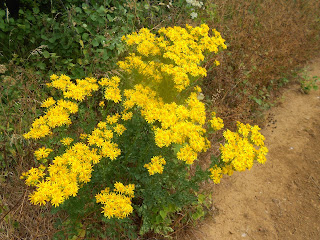 |
| Loose smut Ustilago nuda on barley. Byfield, 20.July, 2003 |
 |
| Poplar leaf with Taphrina populina Byfield Pocket Park. 20 July, 2013 |
 |
| Poplar leaf (lower surface) with Taphrina populi. Byfield Pocket Park. 20 July, 2013 |
 |
| Ragwort, Senecio jacobaea. Byfield, 20 July, 2013 |
Nearby was a robust Ragwort plant. This species has, understandably, received a great deal of adverse publicity over recent years on account of deaths to livestock. Horses are particularly susceptible but tests suggest that a healthy horse would need to eat a quantity of Ragwort equivalent to 7% of its body weight for a lethal dose! From an entomological point of view it is excellent, attracting a considerable range of insects. Today I noted three species of hoverfly calling in for refuelling with nectar and pollen.
A little further along the same hedgerow Hogweed Bonking Beetles, were involved in the activity which has given them their semi-official name. The species, Rhagonycha fulva, is one of the soldier beetles, and it uses the broad umbels of hogweed as a trysting place. Its amorous activities have led to its status as one of Britain's commonest beetles. The dark tips to its hard outer wings (the elytra) make it easily recognisable.
 |
| Rhagonycha fulva mating on the umbels of Hogweed. Byfield, 20 July, 2013 |
No comments:
Post a Comment